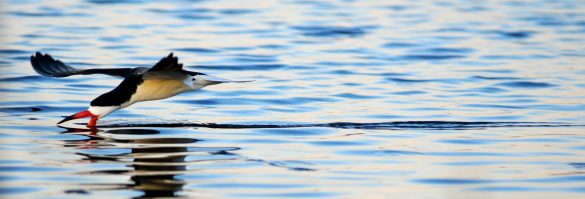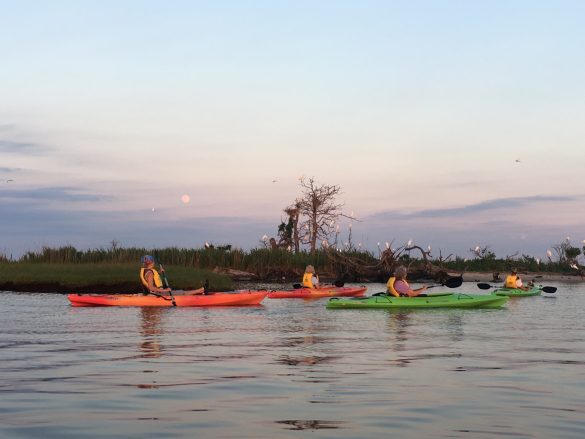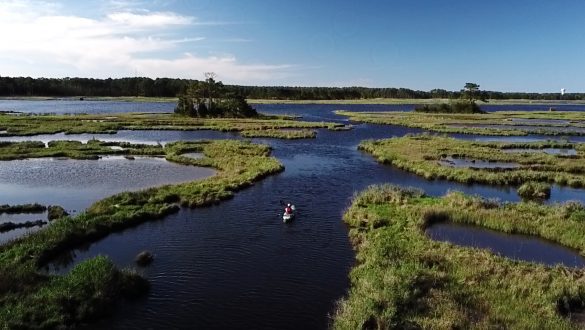During the summer of 1999—our first season operating the watercraft rental concession at Fenwick Island State Park—we spent most afternoons trying to gain the trust of three Mallards: two drakes and one hen. After the morning rush, they’d waddle up from the water, quacking and murmuring, each day coming a little closer to the proffered cracker. The hen always stopped just beyond our outstretched arm. The beautiful males, with their iridescent green heads, were risk-takers—one eventually hopping onto my husband’s leg to gobble bread from his palm.

Evenings, as we pulled up sailboats, ran cables through kayaks, and stashed PFDs into Rubbermaid bins, Black skimmers carved graceful lines in the water, perfectly outlining the contours of the shoreline. Night hawks pursued insects in physics-defying dives and banks. A Great horned owl perched atop the power line pole, asking, “Who? Who? Who?”
In the mornings, before the wind came up, we sent all kayakers on the same triangular route in Little Assawoman Bay: Straight out to Point of Cedars Island, then southeast to Seal Island, then finally along the shoreline back to our beach.

A rookery
Wooded then, Point of Cedars was a rookery for Great blue herons, Green herons, Snowy egrets, and Great egrets. Oyster catchers nested in the sand. Many other birds joined the party, resting on the trees and peeking out of the grasses. In the evening, it sounded like the Philharmonic orchestra, with everyone tuning their instruments separately. You knew you were in for a show.
Seal Island, muddy and covered in marsh grasses, didn’t compare to Point of Cedars for the amount and variety of resident bird life. But the Fenwick Island Yacht Club called it home. Their dock, built on the west side of the island, served as the observation platform for the race committee and marked the start/finish line for their bi-weekly regattas.
When it happened, I can’t exactly say. It’s like trying to pinpoint when two beers began to make you feel groggy the next morning. One spring we returned to our concession and Seal Island was gone. Now, at low tide, its black mud, the consistency of freshly poured cement, lurks two inches below the water, waiting to trap paddlers who don’t heed our warnings. For nourishment, it consumes a steady diet of flip-flops and water shoes with an occasional iPhone for dessert.
A scab of land
Point of Cedars is now a scab of land. All the trees have died. A few fallen skeletons remain. They are used by cormorants, pelicans, and gulls as a resting spot. No more rookeries, no more orchestras.
Now high tides shove water beneath the shed where we used to commune with the Mallards. We no longer see skimmers along the shoreline or hear the shrill call of nighthawks as they fly over the marsh. We’re no longer questioned by the owl.

Yet as one species disappears, another becomes familiar. Summertime now brings Brown pelicans to the bayside. We used to see them only on the ocean. We didn’t see any Green herons last year, but we spotted quite a few Black-crowned night herons. Also last summer, to the glee of our calves and ankles, there were fewer nettles than we’d ever experienced. And the past two summers, for a handful of exciting days, pods of dolphins found their way into “our” bay.
Tidal areas remain static only in our memories. Moving water, over time, moves land. It’s a natural process. But in the scope of erosion-sculpted landscapes, twenty-four years is less than the fraction of a second it takes for a skimmer’s beak to snap shut on its prey. This pace of change doesn’t feel natural.
We accept a rapidly changing environment like we accept expanding waistlines. Remedies exist, but they’d require uncomfortable lifestyle changes. To protect vulnerable lands, wildlife, and our future, however, we need to change—change hearts, minds, habits, and laws.
Does the loss of a tiny island in a tiny bay make any difference in the long run? We’ll probably never know. Yet I can’t help but feel like we’ve left a treasured gift out in the rain overnight.
Freelance writer Jenifer Adams-Mitchell and her husband, Mitch, have operated Coastal Kayak in Fenwick Island for almost 25 years.